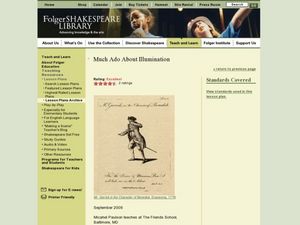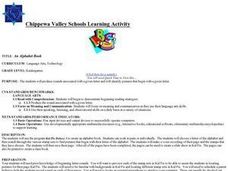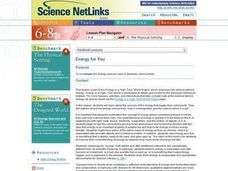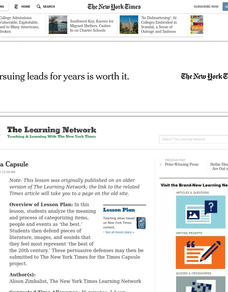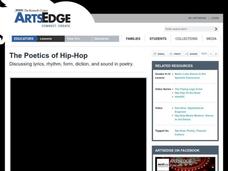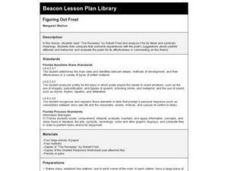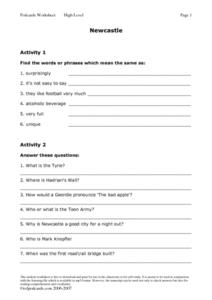Curated OER
The Five Senses
Students recognize how each of the five senses works and define the related terminology. They compare and contrast the means by which the senses gather information about the world. In addition, they research how an assigned sense works...
Curated OER
Much Ado About Illumination
Students analyze the language and characters in the Shakespeare play, Much Ado About Nothing. In this Shakespeare play lesson, students read section of the play and discuss the speech of Benedick and Claudio. Students record the speech...
Curated OER
Introduce Compound Words
First graders practice reading compound words. In this word identification lesson, 1st graders are introduced to several compound words and practice decoding the words by breaking them up into two parts. Students practice reading several...
Curated OER
Understanding the Conservation of Energy
In this conservation of energy worksheet, students read about the law of conservation of energy and about energy distribution. They answer three critical thinking questions about what the law of conservation of energy means to us for...
Curated OER
Physical Science: Magnetism and Electricity
Students use a variety of objects to test for ability to "stick" to a magnet. They perform an experiment to see that electricity in circuits can produce light, heat, sound, and magnetic effects. They discover magnets attract and repel...
Curated OER
Identifying Musical Instruments
First graders identify different musical instruments. In this music appreciation instructional activity, 1st graders discover the different groups and sounds of instruments while learning their names as well. Students write...
Curated OER
Word Families
First graders listen as they are read a book containing exmaples of word families, they listen for rhyming words. They focus on word families, words that have rhyming sounds and share the same spelling patterns. Pupils work in small...
Curated OER
Teaching Phonics Through Poetry
Students understand rhythm and rhyming words in poetry. In this poetry lesson, students listen to poetry and are able to find the ABAB pattern. Students recognize the "ow" sound. Students complete various activities to practice the...
Curated OER
Phonics Lesson Plans Brought to Life With Music
Phonics lesson plans using music for kindergarten through first grade can make learning about letter sounds more fun.
Curated OER
An Alphabet Book
Students demonstrate beginning reading strategies. In this letter recognition lesson plan, students produce sounds associated with given letters and identify pictures that begin with given letters using "Kid's Pix Deluxe 3".
Curated OER
Applied Science - Science and Math Lab
Students explore the senses. In this Applied Science lesson, students investigate the items in "feely" boxes with their hands, both touching the items and shaking the boxes to hear the sound the items make. Students also smell and taste...
Curated OER
Homonym Game
Students use structural analysis and context clues to determine meanings of words. They play a game to decode, read, and comprehend written text . They treat others with kindness and fairness and include others in learning and play...
Curated OER
Energy for You
Students investigate the energy sources used in student's communities. They explore where the energy comes from, how it is transported, and the uses to which it is put. They review the meanings of vocabulary renewable and newable resources.
Curated OER
The Phrasal Verbs of To Go Exercise
For this recognizing "to go" verbs worksheet, students match the phrasal verbs with their meanings and translate them, and then use them to fill in the blanks. Students write 31 answers.
Curated OER
Time in a Capsule
Students analyze the meaning and process of categorizing items, people and events as 'the best.' students then defend pieces of literature, images, and sounds that they feel most represent 'the best of the 20th century.'
Curated OER
The Poetics of Hip Hop
High schoolers consider the role of rhythm, form, diction, and sound in poetry. In this integrated arts lesson, students discuss the attributes of poetry as they analyze Shakespearean sonnets, hip hop music lyrics, and poems by...
Curated OER
Mapping The Ocean Floor
Young scholars explore and analyze the bottom structure of underwater habitats. They describe and explain what can't see through the collection and correlation of accurate data. Learners assess that technology is utilized as a tool for...
Curated OER
Figuring Out Frost
Fourth graders read "The Runaway" by Robert Frost and analyze it for its literal and symbolic meanings. They compare their personal experiences with the poet's suggestions about youthful attitudes and behaviors. Some nice worksheets are...
Curated OER
Taha Moana - The Sea
Students discuss language, meanings and ideas in a range of texts related to the sea. They write instructions, explanations, arguments and factual accounts, express personal viewpoints on topics related to the sea.
Curated OER
Fractions
Fourth graders explore the meaning of equivalent fractions, find equivalent fractions, and explain why the fractions are equal. They share their ideas about equivalent fractions. Students answer the question: "What makes equivalent...
Curated OER
Homonyms
In this homonyms worksheet, students read 6 pairs of words which sound alike but are spelled differently. Students draw a picture for each that shows the meaning.
Curated OER
Newcastle
For this language arts worksheet, learners listen to a podcast. They listen for words that mean the same as 6 words or phrases. Students answer 7 comprehension questions. A cloze activity of the article is included for learners.
Curated OER
Satire in Fiction
Twelfth graders identify satire in various fictional texts. In this language arts lesson, 12th graders will learn to define satire, parody, and caricature. Students will identify different forms of satire in historical and...
Curated OER
What is Timbre?
Students analyze the differences in similar songs. In this music appreciation lesson, students discover the meaning of timbre and how it can drastically change similar pieces of music. Students sing two pieces of music with...

